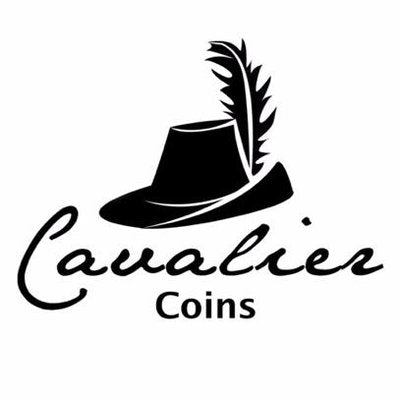You’ve found an old half penny—is it pocket money or a small fortune? The truth is, its value can swing from just a few pence to hundreds of pounds, all depending on its age, rarity, and overall condition.
A common half penny from the 20th century, worn from years of circulation, might not be worth much more than its face value. But a rare date in pristine condition? That’s a completely different story. Collectors will often pay a premium for those hard-to-find gems.
What Is a Half Penny Worth in Simple Terms
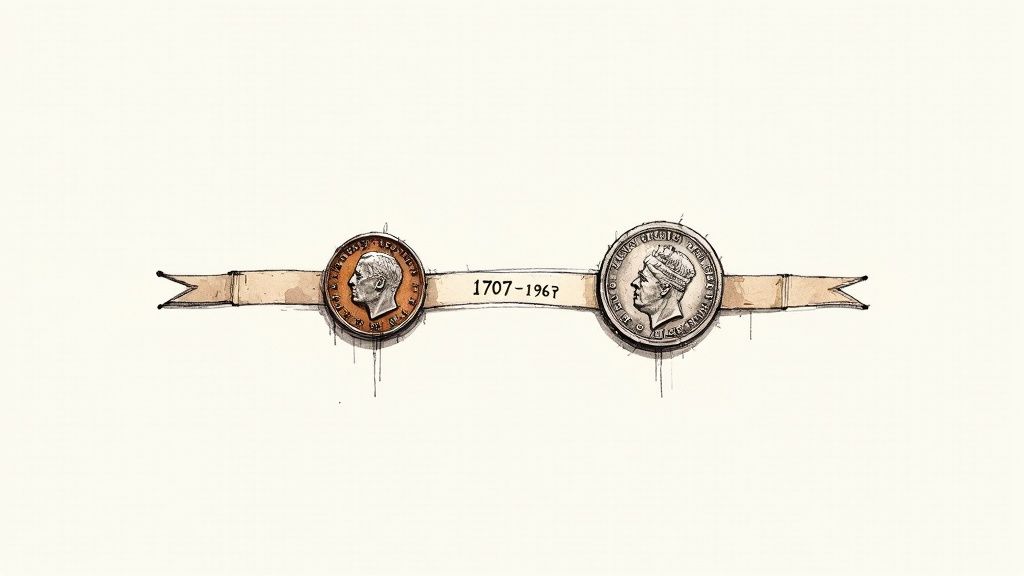
Think of it like discovering an old car tucked away in a dusty barn. Most of what you find might be rusted-out relics, but every now and then, someone uncovers a priceless classic. The same goes for half pennies. There's no single answer to "how much is a half penny worth"—it’s a whole spectrum of possibilities.
This value is deeply rooted in its place in British history. The classic halfpenny, or 'ha'penny', was a staple of our currency for centuries, worth 1/480th of a pound sterling before it was finally discontinued in 1969.
Then came decimalisation. A new, smaller decimal half penny was introduced in 1971, worth 1/200th of a pound, but it didn't last long. Rising inflation made it practically worthless, and it was officially demonetised in 1984. You can read up on the coin’s full journey over on Wikipedia.
Quick Guide to Half Penny Values
To give you a better sense of what you might have, we've put together a simple guide to potential values. Think of this as a starting point, not a definitive price list. It breaks down what you might expect based on the coin's era and general condition.
| Coin Era | Common Circulated Value | Excellent Condition Value | Rare/Uncirculated Value |
|---|---|---|---|
| Georgian (1714-1830) | £5 - £20 | £50 - £150+ | £200 - £1,000+ |
| Victorian (1837-1901) | £1 - £10 | £20 - £100+ | £100 - £500+ |
| Edward/George (1901-1952) | < £1 | £5 - £20 | £25 - £150+ |
| Elizabeth II (1953-1967) | < £0.50 | £1 - £5 | £10 - £50+ |
| Decimal (1971-1984) | Face value | < £1 | £1 - £10 |
These figures are estimates, of course. The actual market value can shift depending on collector demand, recent auction sales, and the unique characteristics of your specific coin.
While this table gives you a basic framework, the real story of your coin’s value lies in the tiny details. The specific mint year, any unique errors, or its specific lustre can dramatically change its worth. For a deeper look, check out our guide on how to determine a half penny's value.
The Key Factors That Determine a Half Penny's Value
Figuring out what a half penny is truly worth means looking past its face value and digging into three core elements. A coin's value is really a story told by its rarity, condition, and mintage. These three pillars work together, and understanding them is what separates a common piece of history from a real collector’s prize.
Think of rarity in simple supply and demand terms. If millions of a particular half penny were minted, but only a handful of collectors are after one, the value will stay low. But if very few were ever made and lots of people are trying to track one down, the price naturally starts to climb.
This infographic gives a great visual breakdown of how a half penny's age, rarity, and condition come together to shape its overall worth.
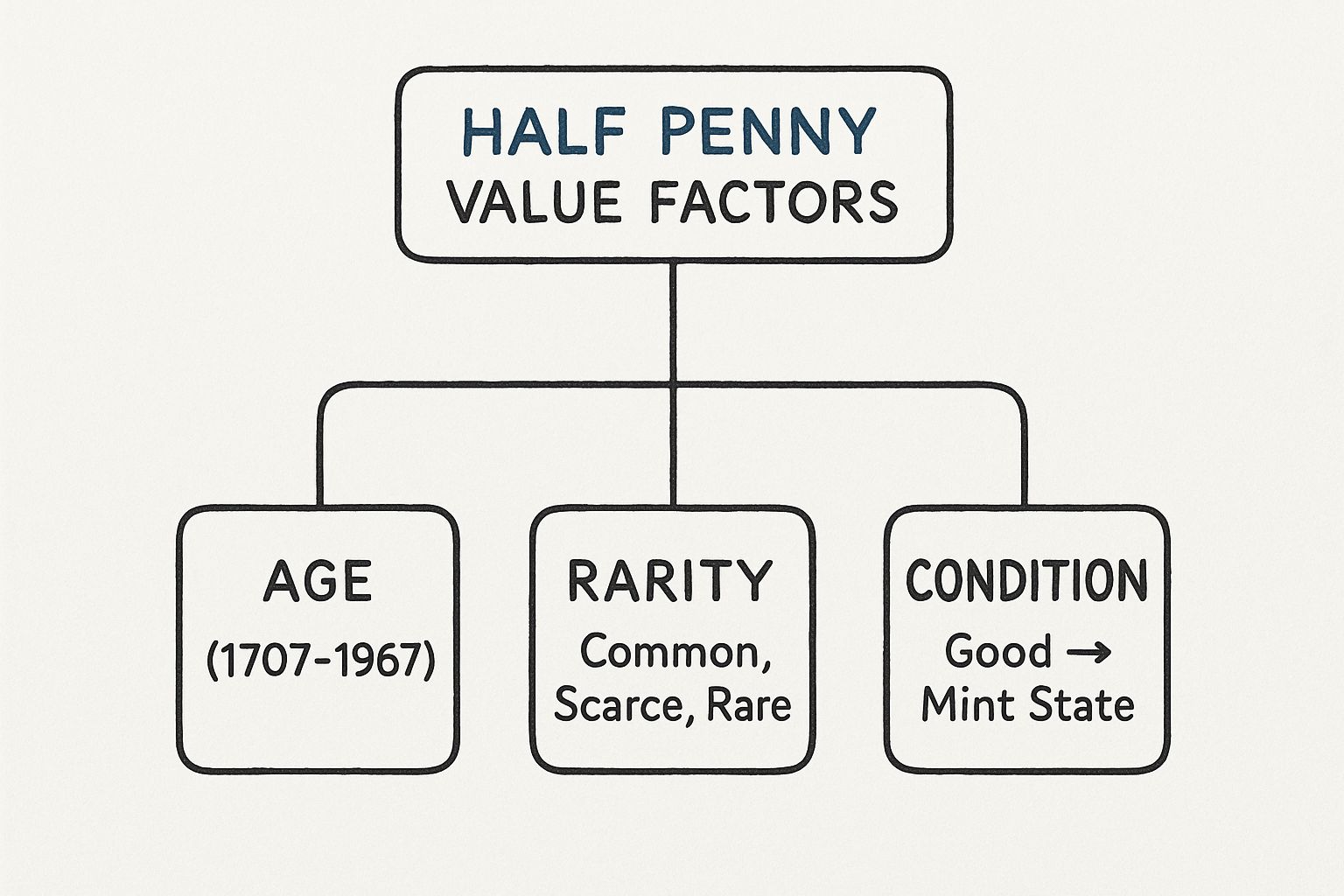
As you can see, these three factors are the main drivers of value, each playing a crucial part in the final appraisal of any coin.
The Importance of Coin Condition
The condition, or grade, of a coin is probably the single biggest multiplier of its value. It’s like comparing a flawless painting to one that’s faded and torn; the difference in worth is astronomical. A coin that never saw a day of circulation and still has its original mint lustre is worlds apart from one worn smooth by countless transactions.
Even a common-date half penny can fetch a respectable price if it’s in "Uncirculated" or "Mint State" condition. It’s the tiny details that make all the difference—the sharpness of the monarch's portrait, the crispness of the lettering.
A coin's grade is its official report card. Even a single step up the grading scale, say from "Very Fine" to "Extremely Fine," can sometimes double or even triple its market value, especially for the rarer dates.
This is exactly why collectors place such a high premium on preservation. A coin’s journey through history is etched right onto its surface, and the less wear it shows, the more valuable that story becomes.
Understanding Mintage and Rarity
Finally, we get to mintage. This figure tells you exactly how many coins of a specific year and mint were produced, and this is where the real treasure hunt begins. A year with a high mintage number, like 1943 when over 74 million half pennies were struck, will almost always be a common, low-value coin.
On the flip side, a year with a low mintage figure creates scarcity right from the get-go. These key dates or varieties with limited production runs are the holy grail for collectors. These can include:
- Low Production Years: Certain years where the Royal Mint simply produced far fewer coins than usual.
- Minting Errors: Mistakes made during production, like double strikes or off-centre designs, which create unique and sought-after oddities.
- Specific Varieties: Minor design tweaks within the same year, such as a toothed versus a beaded border.
For example, many Victorian-era half pennies had much smaller production runs than their 20th-century counterparts, making them naturally scarcer. Knowing the mintage figure for your half penny is the first step to uncovering its potential rarity and, ultimately, its true value.
A Journey Through Half Penny History and Value
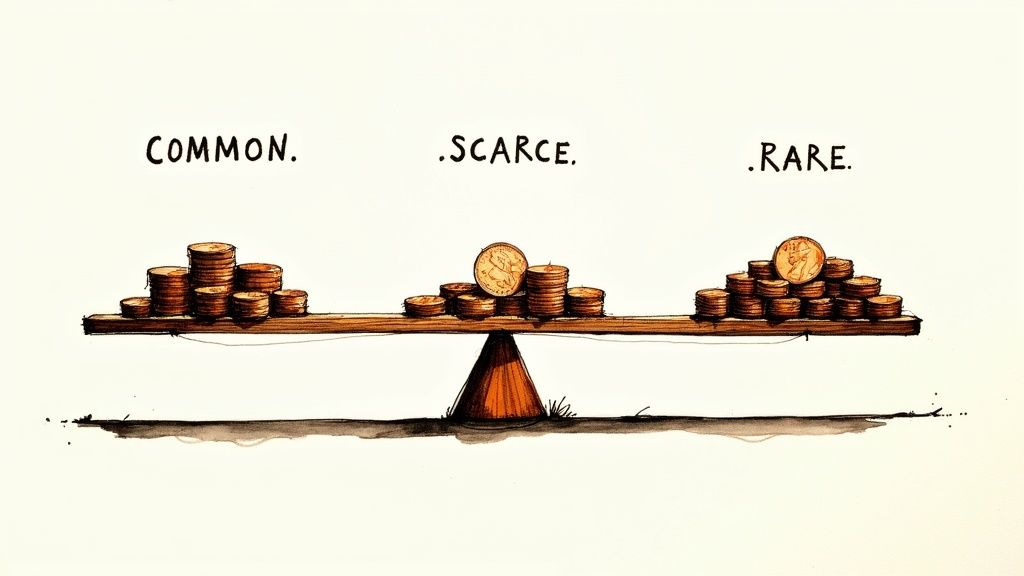
Every old half penny you find is more than just a piece of metal; it’s a tiny time capsule from British history. To really get a feel for what a half penny is worth today, you have to understand its journey. It’s a story that spans centuries, full of changes in monarchs, metals, and the very idea of money itself.
The earliest halfpennies were a world away from the familiar bronze coins. They were actually struck from silver, and their value was simple: it was the value of the silver they were made from. In an age before complex financial systems, a coin’s worth was literally its weight in precious metal. This gave these early pieces an intrinsic value that most modern coins just don't have.
As time went on, this direct link between a coin's metal content and its face value started to shift, paving the way for the half penny we know and love.
The Shift to Bronze and the Victorian Era
The Victorian era was a game-changer for British money. Thanks to the Industrial Revolution, new manufacturing methods became possible, and in 1860, the half penny made the leap from hefty copper to a sleeker, more durable bronze. This new bronze coin would become the standard for the next hundred years.
Victorian half pennies are a huge favourite among collectors. It’s not just because of their classic designs, but because of the incredible variety produced during Queen Victoria’s long reign. Some years saw millions of coins minted, while others were far more limited. This creates a fascinating treasure hunt for collectors, separating the common dates from the truly scarce ones.
The specific year and monarch on a half penny act as a historical timestamp. A coin from a wartime period, for instance, might be made from a different metal due to resource shortages, instantly making it a point of interest for numismatists.
Understanding this context is everything. The story behind the coin—why it was made, what was happening in the country at the time, and how many were produced—is what gives it value today.
From World Wars to Decimalisation
The 20th century saw the half penny survive two World Wars and witness the end of the pre-decimal system. Coins from the war years are particularly interesting. Resource shortages sometimes forced the mint to change the metal composition or simply produce fewer coins, creating accidental rarities for future collectors.
The biggest shake-up, of course, arrived in 1971 with decimalisation. The old, familiar bronze half penny was swept away, replaced by a tiny new version that completely changed its size and role in our currency. This new decimal halfpenny didn’t last long. Inflation quickly made it almost worthless, and it was officially withdrawn from circulation for good in 1984.
The collector, or numismatic, value of halfpennies has soared, especially for the older and rarer coins. Early medieval pieces from the reigns of monarchs like Henry I are incredibly sought-after for their age and scarcity, often fetching hundreds of pounds. You can find more great insights into halfpenny collectability at BullionByPost. This long history, from ancient silver to modern bronze, is why placing your coin in its correct era is the very first step in discovering its true value.
How to Grade Your Half Penny Like a Pro
Now that you know what makes a half penny valuable, it’s time for the hands-on part. Assessing your coin’s condition, a process we call grading, is probably the single most important skill you can learn to figure out its true worth. It sounds technical, but don't worry, it's more straightforward than you might think.
Imagine you're judging a photograph. An 'Uncirculated' coin is like a brand new, high-resolution print – every detail is crisp and perfectly defined. At the other end of the spectrum, a 'Poor' grade coin is like a blurry, faded old photo where you can just about make out the main subject. Your task is to see where your half penny fits on that scale.
From Uncirculated to Poor: A Visual Guide
Every time a coin is passed from hand to hand, it picks up tiny marks and scratches. This contact gradually wears down the sharp details it had when it was first struck at the mint. When you grade a coin, you're essentially playing detective and figuring out how much life it has seen.
Here are the main grades collectors use, from the best possible condition down to the worst:
- Uncirculated (UNC): A perfect coin. It looks just as it did the day it was made, with no signs of wear and its original mint lustre shining.
- Extremely Fine (EF): You can only see the slightest wear on the very highest points of the design. Almost all the detail is still razor-sharp.
- Very Fine (VF): The coin shows some light, even wear. The major details are clear, but finer points, like the strands of the monarch's hair, have started to soften.
- Fine (F): There's moderate wear across the whole coin. The main design is still clear, but many of the delicate details are now gone.
- Good (G): The coin is heavily worn down, but you can still make out the main design, the full date, and the lettering.
- Poor (P): So much wear that the design is nearly flat. It's often difficult to identify the coin or read the date.
This brilliant image from Wikipedia gives you a fantastic side-by-side look at different coin grades. It really helps to see the differences in wear and tear.
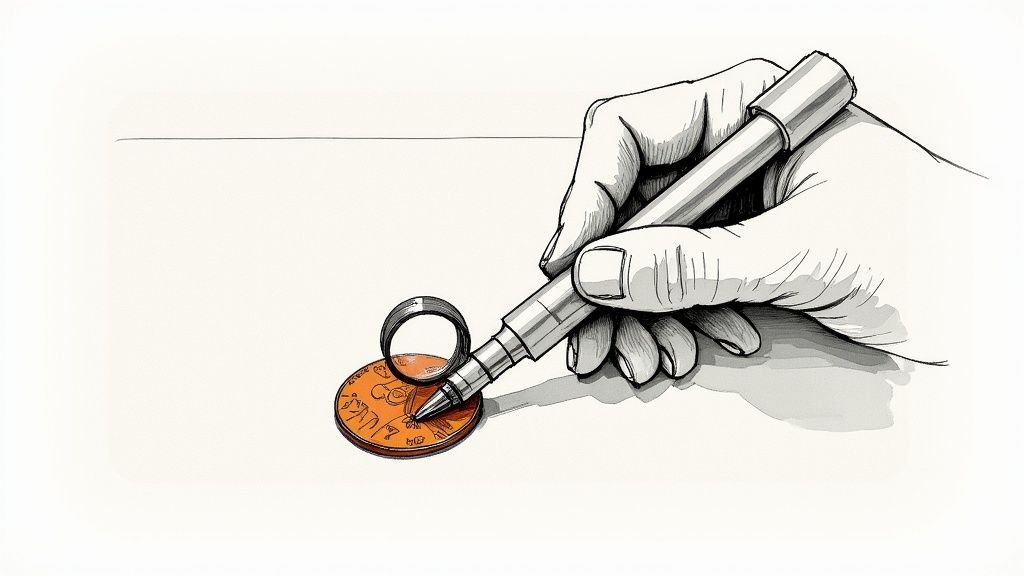
As you can tell, the jump from a high grade to a low one is massive, and it has a huge effect on what a collector will pay for a half penny.
To give you a better idea of what to look for, I've put together a simple table. It's a quick reference to help you start identifying the grade of your coins.
Simple Coin Grading Guide for Half Pennies
| Grade | Description of Wear | Key Features to Check |
|---|---|---|
| Uncirculated (UNC) | No wear at all. Has original mint shine. | Perfect, sharp details everywhere. No friction or rubbing on high points. |
| Extremely Fine (EF) | Very slight wear on the highest points only. | Look for the first hint of flatness on the monarch's hair and Britannia's shield. |
| Very Fine (VF) | Light, even wear across the surface. | Finer details like hair strands and shield lines are starting to merge. |
| Fine (F) | Moderate, obvious wear. Many details are gone. | The monarch's hair is mostly flat. Britannia's features are softened. |
| Good (G) | Heavy wear. The design is visible but very worn. | Outline of the monarch's head is clear, but all internal details are gone. |
| Poor (P) | Almost completely smooth and flat. | The date may be difficult to read. The design is just a faint outline. |
Use this as a starting point. The more coins you look at, the more your eye will become trained to spot the subtle differences between grades.
Key Details to Inspect on Your Half Penny
To grade accurately, you need to know exactly where to look for those first signs of wear. So, grab a magnifying glass and let's zoom in on the specific areas of a classic British half penny.
On the Obverse (The Monarch's Head):
- The Hair: Pay close attention to the strands of hair just above the monarch's ear and at the highest point of the head. This is almost always the first place wear appears.
- The Eyebrow and Cheek: Look for any flatness on the high points of the face. In higher grades, these features should be well-defined.
- The Lettering: The letters around the rim (the legend) should be sharp and clear, not smoothed over.
On the Reverse (Britannia):
- Britannia’s Shield: The lines making up the Union Flag on the shield should be distinct. On worn coins, they blur together.
- Her Helmet and Hand: Check for wear on the plume of her helmet and the fingers of the hand holding the trident.
- The Date: Make sure all four numbers of the date are bold and easy to read.
A great rule of thumb for collectors is that the value often hides in the details that disappear first. Keeping the fine lines of the monarch’s hair can be the difference between a coin worth £1 and one worth £50.
By carefully checking these key spots, you can make a much more confident assessment of your coin's grade. This brings you one step closer to understanding its real value on the collector's market.
Identifying Rare Half Pennies Worth Looking For
Right, this is where the real fun begins—the treasure hunt. While the vast majority of half pennies you'll come across are common, a handful are genuine rarities that can transform a simple jar of old change into a significant find. The secret is knowing which dates, little variations, and minting errors to keep an eye out for.
Think of yourself as a detective. You're not just glancing at a coin; you're hunting for clues that tell a far more interesting story. These clues might be a tiny minting mistake, a year with low production numbers, or a subtle design tweak that most people would never notice. Spotting these is what elevates coin collecting from a simple hobby to a thrilling search.
Key Dates with Low Mintage Numbers
The most direct path to finding a rare half penny is simply checking its date. The Royal Mint’s production levels fluctuated dramatically over the years, which naturally created scarcity. Some years saw tens of millions of coins minted, while others saw far, far fewer.
A great example is the 1862 half penny. Loads were made, but finding one with a specific die number (like the 'G' tucked below the wreath) makes it much scarcer. In the same way, certain Edward VII and George V dates had surprisingly low mintages compared to the years surrounding them, making them prized possessions for collectors trying to build a complete date run.
For many collectors, the 'key date' is the cornerstone of their collection. A low-mintage coin, even in a lower grade, is often more desirable than a common date in perfect condition simply because of its inherent scarcity.
Always, always pay close attention to the year. A single digit can be the difference between a coin worth a few pence and one worth dozens of pounds.
Famous Errors and Unique Varieties
Beyond just the key dates, minting errors are responsible for some of the most fascinating and valuable half pennies out there. These are complete accidents—one-offs that somehow slipped past the mint's quality control, turning them into unique collector’s items. Look out for things like off-centre strikes, where the design is wonky, or 'mules', where the obverse and reverse dies are a mismatch.
Design variations are another hot area. A famous example is the 1925 'Toothed Border' half penny. For a brief time, the design switched from a beaded border to a toothed one, creating two different versions in the same year. The toothed variety is much rarer and, as a result, more valuable. While these coins are rooted in British history, the principles of spotting rare variations apply across the board; you can even explore expert tips to identify ancient coins which often share similar characteristics of rarity.
Here are a few specific things to watch out for:
- Victorian 'Bun Head' Varieties: Check for small changes in Queen Victoria’s portrait, especially in the fine details of her hair and the shape of the date numerals.
- The 1953 'No Shoulder Strap' Penny: Okay, this is a penny, but it shows the kind of detail to look for. A similar tiny missing element could easily exist on half pennies.
- Wartime Composition Changes: During the World Wars, metal shortages sometimes led to tweaks in the bronze alloy. This created slight variations in colour and weight that are now quite collectible.
Getting your eye in and scrutinising your coins for these subtle differences is the best way to uncover their hidden potential. It's how you truly begin to understand what makes a half penny worth more than its face value.
Getting Your Half Penny Professionally Appraised and Sold
You’ve done the groundwork—you've checked the date, squinted at the details, and made your best guess at the coin's condition. If you think you might be sitting on something special, it's time to bring in the experts. This is the moment you transition from a curious collector to an informed seller, making sure you get a fair price for your find.
Figuring out how much is a half penny worth on the open market isn't just about what a price guide says; it requires a trained eye. While your own research is a brilliant start, a professional numismatist can spot the subtle variations, confirm authenticity, and give you a valuation grounded in today's market. This single step can save you from undervaluing a rare gem or getting your hopes up over a common coin.
Choosing the Right Path for Valuation and Sale
So, where do you go from here? You have a few solid options, and the best one really depends on your coin and what you're hoping to achieve.
- Local Coin Shops: This is often the quickest route. It’s a great choice for getting instant feedback and making a straightforward sale, especially for coins that are common or of moderate value.
- Professional Grading Services: For potentially valuable coins, services like PCGS (Professional Coin Grading Service) are the gold standard. They'll authenticate and grade your coin before sealing it in a protective slab. This officially certified grade can massively boost its value and appeal to serious buyers.
- Auction Houses: If you have an exceptionally rare or high-grade half penny, an auction house is your best bet. The thrill of competitive bidding can drive the price far beyond initial estimates, often setting new records for a particular coin.
Remember, a professional appraisal isn't a cost—it's an investment. The fee for grading can often pay for itself many times over by giving buyers the confidence they need to pay a premium price for a fully authenticated coin.
Before you jump in, it pays to understand what the professionals are looking for. To get a better feel for the process, reading up on expert coin collection valuation tips for UK coins can put you a step ahead. Armed with this knowledge, you can walk into an appraisal prepared, ask the right questions, and sell your coin with complete confidence.
A Few Final Questions on Half Penny Value
Got a few lingering questions? It's completely understandable. Here are some quick, clear answers to the queries we hear most often from people trying to work out what their half penny is worth.
Are All Old Half Pennies Automatically Valuable?
Not necessarily, and this is a common misconception. While age is certainly a factor, the real drivers of value are rarity and condition.
A half penny from the 1940s that’s been heavily circulated and is in poor shape might only be worth the value of its metal. On the flip side, a rarer coin from that very same era in crisp, uncirculated condition could be worth a significant amount more. You always need to check the specific year and grade to get a true sense of what you're holding.
What's the Difference Between Pre-Decimal and Decimal Half Pennies?
These are two completely different coins from two different eras of British currency. The pre-decimal half penny, affectionately known as the ‘ha'penny,’ was part of the old pounds, shillings, and pence system. It was worth 1/480th of a pound and was taken out of circulation in 1969.
The decimal half penny, which came along in 1971, was much smaller and was worth 1/200th of a pound. As inflation took its toll, its value diminished, and it was officially withdrawn in 1984.
A critical tip for every collector: Whatever you do, never clean old coins. You might think you're helping, but cleaning can cause microscopic scratches and strip away the natural patina. This drastically reduces a coin's numismatic value, as collectors prize coins in their original, untouched state.
If you can't even identify a coin because of the grime, it's always best to consult a professional numismatist before you do anything that might cause accidental, and irreversible, damage.
For expert valuations and to explore a wide range of collectible coins, visit Cavalier Coins Ltd. Discover rare finds and build your collection at https://www.cavaliercoins.com.
